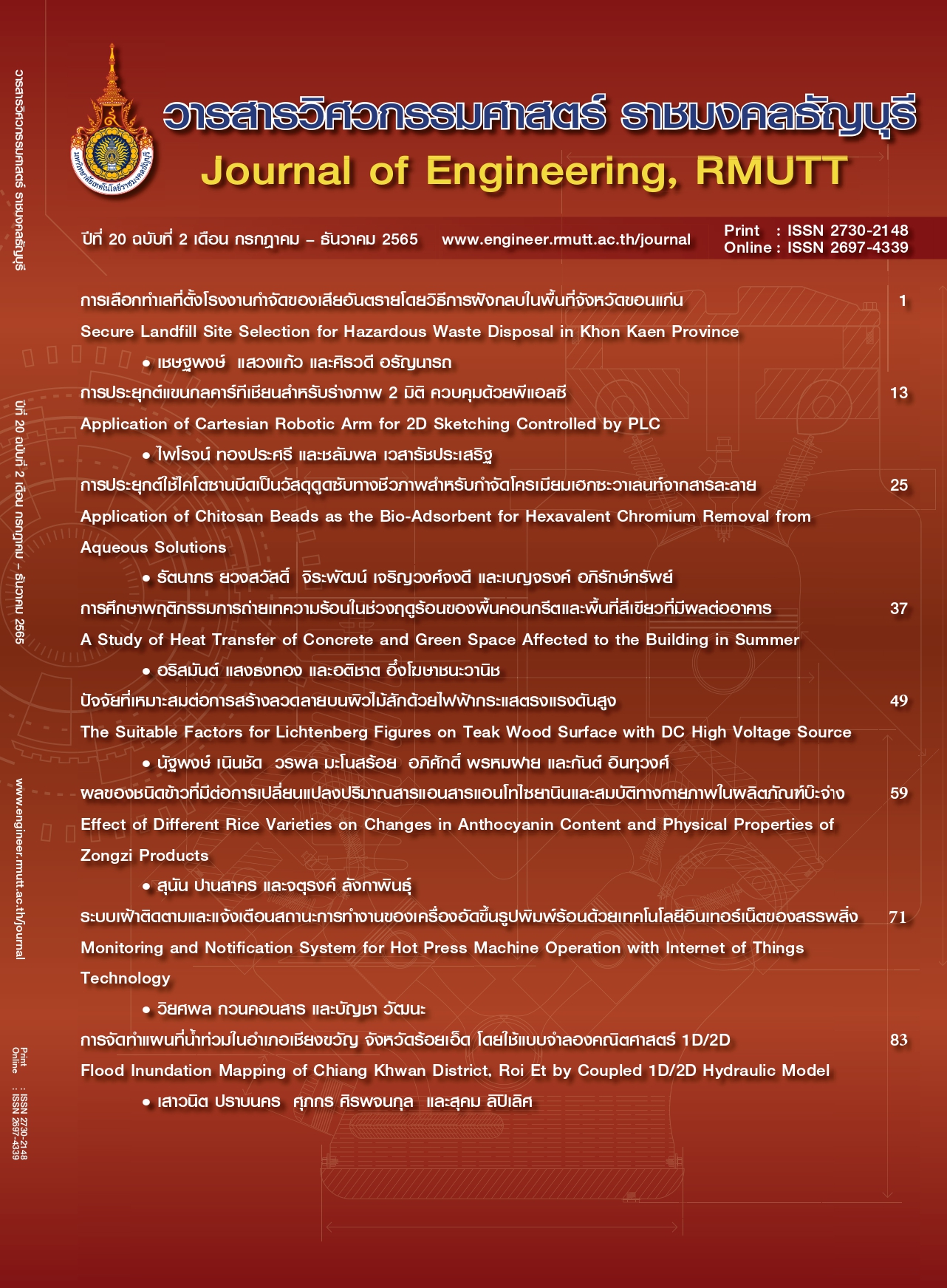ผลของชนิดข้าวที่มีต่อการเปลี่ยนแปลงปริมาณสารแอนโทไซยานินและสมบัติทางกายภาพในผลิตภัณฑ์บ๊ะจ่าง
Main Article Content
บทคัดย่อ
งานวิจัยศึกษาผลของชนิดข้าวที่มีต่อการเปลี่ยนแปลงปริมาณสารแอนโทไซยานินและสมบัติทางกายภาพในผลิตภัณฑ์บ๊ะจ่าง ข้าวที่ใช้คือ ข้าวเหนียวขาว ข้าวเหนียวดำ และข้าวไรซ์เบอรี่ แบ่งเป็นตัวอย่างที่ 1 ข้าวเหนียวขาว 100 เปอร์เซ็นต์ ตัวอย่างที่ 2 ข้าวเหนียวขาวผสมข้าวเหนียวดำอย่างละ 50 เปอร์เซ็นต์ ตัวอย่างที่ 3 ข้าวเหนียวขาวผสมข้าวไรซ์เบอร์รี่อย่างละ 50 เปอร์เซ็นต์ และตัวอย่างที่ 4 ข้าวเหนียวดำผสมข้าวไรซ์เบอร์รี่อย่างละ 50 เปอร์เซ็นต์ พบว่าการใช้ข้าวเหนียวขาว 100 เปอร์เซ็นต์ ให้วอเตอร์แอคติวิตี้ ต่ำสุด 0.854 ในขณะที่ใช้ข้าวเหนียวสูตรผสมวอเตอร์แอคติวิตี้ มีค่าระหว่าง 0.888-0.929 สอดคล้องกับความชื้นที่มีค่าใกล้เคียงกันทั้ง 4 ตัวอย่าง (51.30- 57.25 เปอร์เซ็นต์มาตรฐานเปียก) ค่าความแข็งของการใช้ข้าวเหนียวขาว 100 เปอร์เซ็นต์ ให้ค่าความแข็งสูงสุด 32.14 นิวตัน ในขณะที่ตัวอย่างข้าวเหนียวดำผสมข้าวไรซ์เบอร์รี่ ให้ค่าต่ำสุด 8.97 นิวตัน เมื่อนำไปทดสอบความพึงพอใจของผู้บริโภคทั้ง 4 ตัวอย่าง พบว่าข้าวเหนียวดำผสมข้าวไรซ์เบอร์รี่ มีคะแนนความชอบที่ระดับชอบปานกลางถึงชอบมาก (6.60-7.57) ซึ่งสูงสุดในด้านลักษณะปรากฏ กลิ่น สี รสชาติ และความชอบโดยรวม การทดสอบค่าสีพบว่าการใช้ข้าวเหนียวขาว 100 เปอร์เซ็นต์ ให้ค่า L* สูงสุดและมีแนวโน้มลดลงเมื่อผสมกับข้าวชนิดอื่นและให้ผลเช่นเดียวกับค่าความเป็นสีเหลือง (b*) ในขณะที่ค่าความเป็นสีแดง (a*) เพิ่มขึ้นเมื่อนำข้าวเหนียวดำผสมข้าวไรซ์เบอร์รี่ และการทดสอบสารแอนโทไซยานินในข้าวเหนียวขาว 100 เปอร์เซ็นต์ ให้ค่าปริมาณสารแอนโทไซยานินต่ำสุดเท่ากับ 0.063 กรัมต่อกรัมน้ำหนักแห้ง เมื่อนำข้าวไรซ์เบอรี่ และข้าวเหนียวดำ มาผสมพบว่าปริมาณสารแอนโทไซยานินเพิ่มขึ้นและให้ค่าระหว่าง 0.193-0.220 กรัมต่อกรัมน้ำหนักแห้ง
Article Details

This work is licensed under a Creative Commons Attribution-NonCommercial-NoDerivatives 4.0 International License.
บทความ ข้อมูล เนื้อหา รูปภาพ ฯลฯ ที่ได้รับการตีพิมพ์ในวารสารแนวหน้าวิจัยนวัตกรรมทางวิศวกรรม ถือเป็นลิขสิทธิ์ของวารสารฯ เท่านั้น ไม่อนุญาติให้บุคคลหรือหน่วยงานใดคัดลอกเนื้อหาทั้งหมดหรือส่วนหนึ่งส่วนใดไปเผยแพร่เพื่อกระทำการใด ๆ ที่ไม่ถูกต้องตามหลักจริยธรรม
References
Panarangsan T. Project to set up the Ba-Jang (Traditional Chinese Steam Rice) wholesale business of Thailand. (GrandMa Ba-Jang 4.0). M. Com. Arts (Entertainment Management and Production), Graduate School, Bangkok University. 2017. (in Thai)
Bangkok Business. Wai Bac Chang' Festival 2021 opens the legend of worshiping the dragon god. 2021 [cited 2021 December 22]. Available from: https://www.bangkokbiznews. com/lifestyle/886794
BLT Bangkok. Health trends are strong. Modern urban people set goals for a good and happy life. 2021 [cited 2021 December 22] Available from: https://www.bltbangkok.com/bangkok-update/4405/.
Sirisoontaralak P, Paisarnchareon K. Jacutprakart B. Development of quick prepared chinese zongzi (Chinese Oily Sticky Rice). Agricultural Science Journal. 2012;43(2) (Suppl.):309-12. (in Thai)
Markkool P. Kiaw-ngu glutinous rice: From a genebank to farmers’ fields. Ministry of Agriculture and Cooperatives, Rice Department. 2021. [cited 2021 December 22]. Available from: https://tarr.arda.or.th/preview/item/pvm05Ux-0BScN-GZWpZVq.
Rojanasaroj A, Saengkitikomol W, Tankhamnao T. Antioxidants in black rice, black sticky rice and red rice : protective effect on cytotoxicity and genotoxicity by free radicals and gene expression on lipid accumulation in culture cells. Master of Science in Clinical Biochemistry and Molecular Medicine. Chulalongkorn University. 2008. (in Thai)
Sirithanyalak B. Assessment of anti-inflammatory activity of gamma-oryzanol extract from kam thai rice bran. Research report. Faculty of Pharmacy Chiang Mai University. 2010. (in Thai)
Sukkasem K, Siriwong N.N. Effects of soaking black glutinous rice on nutritional value and texture properties of cooked black glutinous rice. Kasetsart University. Bangkok. 2013. (in Thai)
Kaweewong K, Tansawai A. Production of healthy beverage from black glutinous rice. Research report, Rajamangala University of Technology Lanna. 2013. (in Thai)
Leardkamolkarn V, Thongthep W, Suttiarporn P, Kongkachuichai R, Wongpornchai S, Wanavijitr A. Chemopreventive properties of the bran extracted from a newly-developed Thai rice: The Riceberry. Food Chemistry. 2011;125(3),978–85.
Settapramote N, Laokuldilok T, Boonyawan D, Utama-ang N. Physiochemical, antioxidant activities and anthocyanin of riceberry rice from different locations in Thailand. Food and Applied Bioscience Journal. 2018; 6(Suppl.): 84–94.
Poosri S, Thilavech T, Pasukamonset P, Suparpprom C, Adisakwattana S. Studies on riceberry rice (Oryza sativa L.) extract on the key steps related to carbohydrate and lipid digestion and absorption: A new source of natural bioactive substances. NFS Journal. 2019;17:17-23.
Sapantupong S. Development of bread with riceberry rice bran. RMUTP Research Journal, Vol. 13, No. 2, July-December 2019. (in Thai)
Lee J, Durst R, Wrolstad R. Determination of total monomeric anthocyanin pigment content of fruit juices, beverages, natural colorants, and wines by the pH differential method: collaborative study. J AOAC Int. 2005; 88(50):1269-78.
Diaconeasa Z, Leopold L, Rugin D, Ayvaz H, Socaciu C. Antiproliferative and antioxidant properties of anthocyanin rich extracts from blueberry and blackcurrant juice. International Journal of Molecular Sciences, 2015. 16, 2352–2365.
Yixiao S, Ning Z, Jinlong T, Guang X, Ling L, Xiyun S, Bin L. Advanced approaches for improving bioavailability and controlled release of anthocyanins. Journal of Controlled Release. 2022; 341:285-99.
Khumkhom S. Effect of riceberry flour on physicochemical properties and antioxidant activities of steamed bun. Thai Science and Technology Journal (TSTJ). 2020;28(11):2026-38.
AOAC. Official Method of Analysis. Association of Official Analytical Chemists. 15th ed. Arlington, Virginia, USA; 1990.
Reyes V.G, Jindal V.K. A small sample back extrusion test for measuring texture of cooked rice. Journal of Food Quality. 1989;13(2):109-18.
Suwan N. Effect of coating materials on controlling of browning and weight loss in lychee fruit. Thesis (Master of Science (Biology Department)) Chiang Mai University. 2005. (in Thai)
Ranganna S. Plant pigment. p. 72-93. In S. Ragana (ed.). Manual of analysis of fruit and vegetable produce. Tata McGraw-Hill Publishing Co., Ltd, New Delhi. 1977.
Langsatthong W. Food processing technology. Department of Agro-Industry Technology Faculty of Applied Sciences King Mongkut's Institute of Technology North Bangkok. 6th ed. Tex and Journal Publication Company Limited, Bangkok. 2014. (in Thai)
Suwannaporn P, Pitiphunpong S, Champangern S. Classification of rice amylose content by discriminant analysis of physicochemical properties. Starch Stärke. 2007;59:171-7.
Chepprasop C, Salem H, Anomunee R. Chemical composition and amylose content in local rice variety from Phatthalung rice research center. Sci. Tech. RMUTT J. 2017;7(2):84-97.
Butsita K, Charoenphakdi S. Characteristics of texture and protein content of paddy rice in Phitsanulok Province. The 12th Naresuan Agricultural Fair Conference. Research and Innovation and the Development of the Country Between 21-22 July 2016. 230-6. (in Thai)
Kuanpanya J, Petchawong W, Damrongwattanakul N. Utilization of soy protein and modified starch in fat-reducing Sai Oua products. 46th Academic Conference of Kasetsart University : Agro-Industry Field Between 29 January – 1 February 2008 Kasetsart University. Bangkok. 2012. (in Thai)
Hiemori M, Koh E, Mitchell A. Influence of cooking on anthocyanins in black rice (Oryzasativa L. japonica var. SBR). Journal of Agricultural and Food Chemistry. 2009;57(5):1908-14.
Pichaiyongwongdee S, Rutkajorn N, Pandolsuk S. Teaching documentation culinary science. Printer, M&M Laser Print Limited Partnership, Bangkok. 2011. (in Thai)
Bellido G, Beta T. Anthocyanin Composition and Oxygen Radical Scavenging Capacity (ORAC) of Milled and Pearled Purple, Black, and Common Barley. Journal of Agricultural and Food Chemistry. 2009;57(3):1022-8.
Sompong R, Siebenhandl-Ehn S, Linsberger-Martin G, Berghofer E. Physicochemical and antioxidative properties of red and black rice varieties from Thailand, China and Sri Lanka. Food Chemistry. 2011;124(1):132-40.

